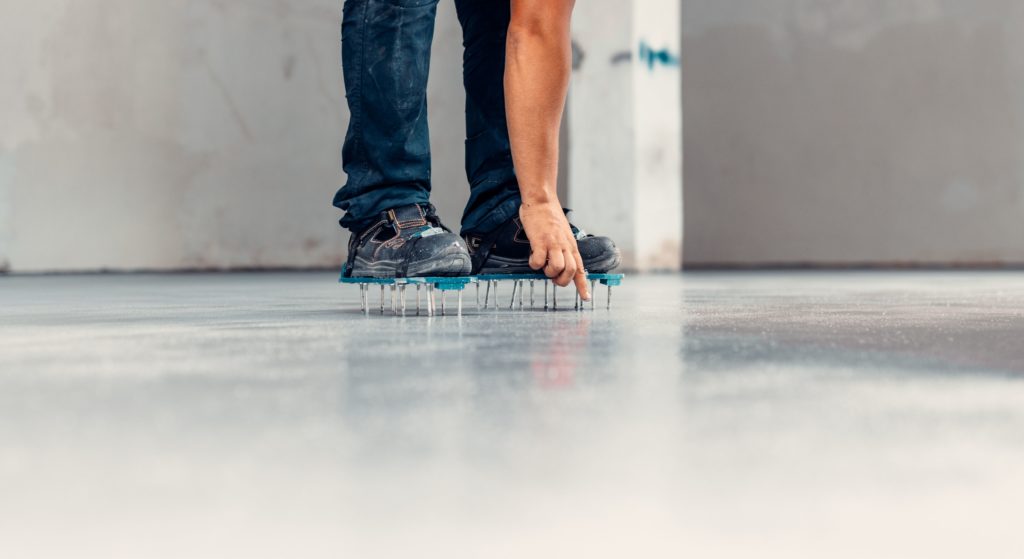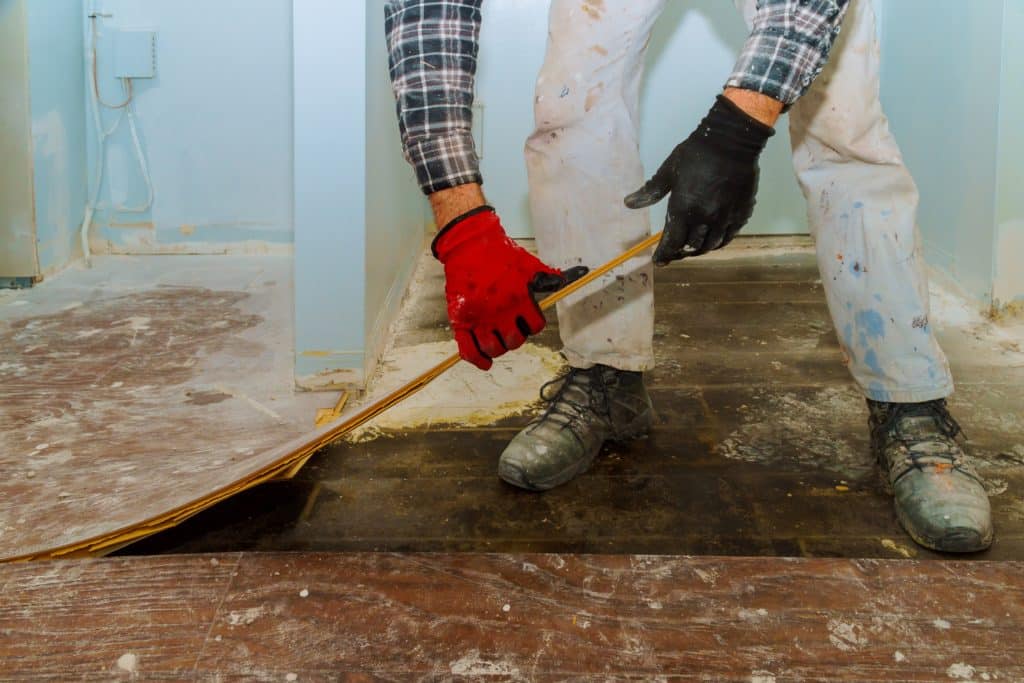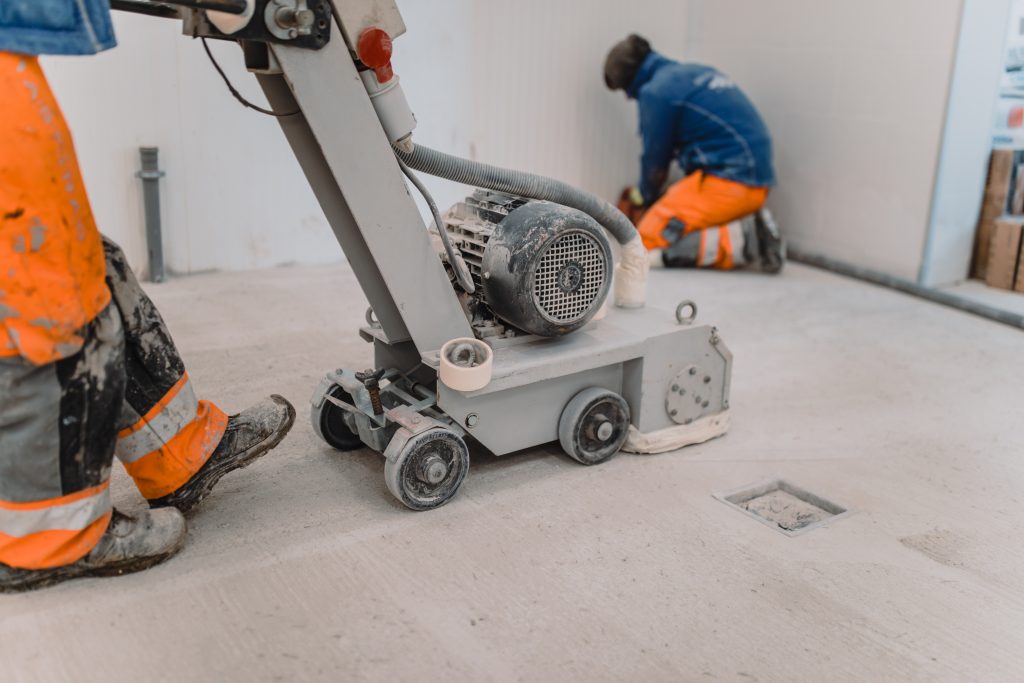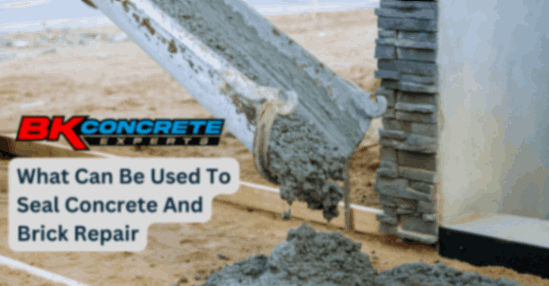When assessing the condition of a concrete floor, homeowners must consider whether cracks or other damage are merely superficial or indicative of deeper structural problems. Addressing concrete floor issues quickly can prevent further deterioration, ensuring the longevity and safety of the home’s foundation.

Properly repairing a concrete floor requires a clear understanding of the extent of the damage. Minor surface cracks might need a simple fix, while uneven floors and larger fissures could demand more comprehensive methods, such as slab jacking or even replacement. Before commencing any repair, it’s essential to identify the underlying causes, as these will determine the most effective repair techniques.
When it comes to repairing a concrete floor, homeowners have various options and resources at their disposal. Resources like Angi can help find qualified contractors, whereas Keystone Basement Systems provide specialized services like PolyLevel® for concrete raising. Additionally, for those tackling smaller repair jobs themselves, instructional guides from wikiHow and Lowe’s offer step-by-step directions, and The Home Depot provides information on the tools and products required.
Understanding Concrete Floor Damage

Concrete floors are valued for their durability and longevity, but they are not immune to damage. Understanding the nature of common issues and assessing the severity of damage are crucial for effective maintenance and repair.
Identifying Common Issues
Concrete damage can manifest in several ways, but cracks are the most prevalent. These can range from hairline fractures to significant cracking. The causes of cracking include subgrade settlement, overloading, and freeze-thaw cycles. Other common problems include pitting and spalling, which occur due to wear and tear or exposure to deicing salts and chemicals.
- Hairline Cracks: Thin but may spread if not addressed.
- Settlement Cracks: Occur when the ground beneath the concrete moves.
- Structural Cracks: Affect the concrete’s integrity and may require immediate attention.
Another issue is surface wear, which happens from repeated traffic and can expose the aggregate within the concrete, leading to a rough surface.
Assessing Severity of Damage
When assessing damage severity, it’s crucial to distinguish between cosmetic issues and structural problems. Surface wear and minor cracks often fall into the former category and typically don’t affect the concrete’s structural performance. They can be addressed with simple maintenance procedures such as sealing or using a concrete-like topping as discussed by Constro Facilitator.
- Cosmetic Issues: Primarily affect appearance.
- Structural Damage: May compromise the concrete’s integrity and load-bearing capacity.
In contrast, wide or deep cracks, especially those that continue to grow, may signify serious underlying issues like foundation settlement. These cracks not only undermine the appearance but also the safety and should be evaluated by professionals, following deeper insights from resources like the Foundation Repair Systems. They may recommend specific repair methods or, in extreme cases, replacement of the concrete floor.
Preparing for Repair

Before one starts the repair process, it is crucial to ensure that the concrete surface is ready for the intervention. Proper preparation involves a thorough cleaning and assembling the right set of tools, which will lead to a more durable and effective repair job.
Cleaning the Area
Initial Cleaning: Begin by removing all surface debris from the concrete area. Use a sturdy wire brush to loosen and clear away any peeling paint, flaking bits of concrete, loose stones, and dusty residue.
- Dust and Fine Particles: Once the loose material is brushed off, a thorough cleaning should follow. Employ a shop vac equipped with a fine dust filter to eliminate all dust and small debris. This is a critical step because dust and particles can impede proper adhesion of repair materials.
- Oil and Grease Stains: Where there’s grease or oil, degreasing is essential. It’s important to cleanse the area using a suitable cleaning agent that can tackle these kinds of stains without leaving residues.
- Rust Removal: If there’s any exposed metal within the concrete that has rusted, such as rebar or wire mesh, use a wire brush to remove rust and prevent future corrosion.
Gathering Necessary Tools
Essential Toolbox: Preparation calls for a well-equipped toolbox. One should ensure they have:
| Tools | Purpose |
|---|---|
| Safety goggles | Protect eyes from debris and dust |
| Dust mask | Prevent inhalation of harmful particles |
| Work gloves | Protect hands during cleaning and repair |
| Knee pads (optional) | Provide knee comfort on hard surfaces |
| Wire brush | Remove loose debris and rust |
| Shop vac | Vacuum fine dust and small particles |
- Protective Wear: Personal protective equipment such as goggles, gloves, and a dust mask are non-negotiable to ensure safety from flying debris and fine dust.
These prep steps lay the groundwork for a successful concrete repair, positioning the repair materials to bond correctly and provide long-lasting durability.
Repair Process and Techniques

The repair of concrete floors calls for a precise selection of techniques and materials to ensure durability and an even finish. It is essential to assess the damage accurately and choose the right method for repair, whether for small fissures or wide-scale resurfacing.
Fixing Small and Hairline Cracks
For small and hairline cracks, the use of a sag-resistant mortar is essential. First, one must clean out the crack to remove any loose debris. A concrete repair application procedure recommends then filling the crack with a suitable patching compound using a trowel, ensuring the compound is pressed firmly into the crack for optimal adhesion.
Managing Large Cracks and Crumbling
Larger cracks and areas where the concrete is crumbling require more robust repairs. Start by removing any unstable concrete and cleaning the area thoroughly. A solid repair calls for a cement-rich mortar or concrete patching compound that can be applied with a trowel to fill the voids. To restore the beauty of your concrete surface with large cracks, it’s vital to apply the patching material in layers, allowing each layer to set before applying the next.
Resurfacing the Concrete Floor
When the damage is more extensive, resurfacing the entire concrete floor may be necessary. This starts with preparing the surface: all cracks and holes should be repaired, and the surface must be cleaned to guarantee proper adhesion of the overlay. A mixing of concrete overlay material should be made following the manufacturer’s instructions. Using a trowel, the mixed material is then spread over the surface to create a new, smooth layer. Resurfacing a concrete floor involves applying the compound evenly across the floor and smoothing it out to ensure proper leveling. After the resurfacing material is applied, it must be left to cure properly before sealing, to enhance the floor’s durability and appearance.
Finishing and Curing

In repairing a concrete floor, achieving a smooth finish and ensuring proper curing are pivotal for longevity and performance. The application of finishing touches can significantly affect the surface’s durability and appearance.
Applying Finishing Touches
After initial repairs are done and before the concrete dries, one must meticulously work on the finishing touches. Certain tools and materials are essential for this stage:
- Leveling: It’s critical to ensure the surface is level. A straightedge or float is dragged over the concrete to smooth out the surface and level any small hillocks or depressions.
- Texture: Depending on the desired surface texture, different techniques can be used. For a non-slip finish, a broom can be gently dragged across the wet surface to create a broomed texture, which is ideal for outdoor concrete surfaces.
Materials play a significant role in the finishing process:
- Filler: If there are deeper pits or cracks, a concrete filler or putty knife can be used to apply epoxy filler, which should be smoothed out evenly with the surrounding area.
- Sealer: After the filler has cured, a sealer should be applied to protect the repair and extend the floor’s life. This sealer helps to lock out moisture and prevent future cracks.
- Resurfacer: For extensive surface damage, a concrete resurfacer can be used to provide a new surface and can be finished smoothly with a trowel or textured with a broom.
When it comes to curing:
- Drying Time: Concrete requires adequate time to cure and reach its full strength. The drying time can vary, generally taking around 24 to 48 hours to be dry to the touch but can need up to 28 days to fully cure.
- Curing Methods: Methods such as moist curing can be employed; it involves keeping the surface damp to prevent cracks and ensure a stronger, more durable concrete surface.
Maintenance Tips and FAQs
Maintaining Concrete Floors:
Regular maintenance can extend the life of concrete floors. For an indoor setting like a basement or garage floor, they recommend vacuuming or mopping to remove dirt and dust. It’s crucial to avoid saturation during cleaning to prevent water damage.
Temperature & Concrete:
Concrete floors should be kept at a consistent temperature to prevent cracking and heaving. Sudden changes in temperature can be detrimental to the integrity of the concrete, especially in areas like driveways and patios.
Drainage Considerations:
Proper drainage is essential for maintaining outdoor concrete surfaces. Ensure that sprinklers, gutters, and downspouts are directed away from concrete areas to prevent water accumulation.
FAQs:
- Q: How often should my concrete floor be cleaned?
- A: Regular cleaning, as needed, helps maintain appearance and longevity.
- Q: Will heavy rain affect my concrete driveway?
- A: Concrete is durable, but excessive water should drain properly to avoid damage.
- Q: Is sealing concrete necessary?
- A: Yes, sealing helps protect against stains and weather.
For specific repair steps, like making mortar flush for cracks in a concrete floor, expert guidance is useful. Likewise, to fix an uneven concrete floor, attention should be paid to cleaning and preparation before applying a leveling compound. Each project may require different materials and tools for optimal results.

 CALL US NOW
CALL US NOW



